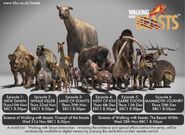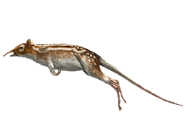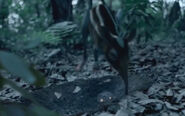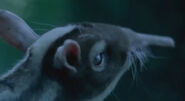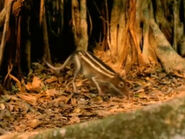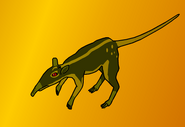Leptictidium was a prehistoric eutherian mammal from the early to late Eocene (50-35 million years ago) that hopped like today's kangaroos and it is not closely related to any of the modern species.[2]
Facts
Leptictidium was a small mammal - about a meter in length - and a common sight in the forests of 50 MYA. Their kind had survived virtually unchanged since the time of the dinosaurs. A typical mammal, the females looked after their offspring until they're old enough to fend for themselves. And they hunted whatever the risk. The cool early morning was an ideal time for them to catch the frogs, lizards, and insects they fed on. They were warm–blooded and fast–moving 24 hours a day. Also, to help track down their prey, Leptictidium had an incredibly acute sense of hearing and a distinctive super–sensitive nose that could twitch to locate food among leaf litter. And they were agile enough to catch even flying insects. Leptictidium needed a lot of food for their size. Like all mammals, this was a price they paid for a warm–blooded metabolism.[3]
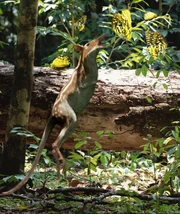
À Leptictidium trying to catch à butterfly
There is still much speculation about the coloration of the Leptictidium per se, but the one seen in WWB are white, with brown upper parts with white horizontal stripes.
Hopping aside, in the front Leptictidium resembled the modern elephant shrews or sengis, primitive mammals, which can still be found today mostly in the African savanna. Just like them, it was a small animal less than a meter in height, and thus it was prey for various carnivores, such as Gastornis and Ambulocetus.
In Walking with... Series
Walking with Beasts
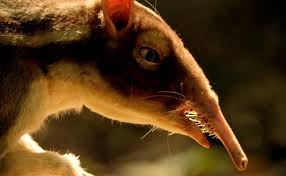
The Leptictidium puppet used for Walking with Beasts
New Dawn
In the first episode of Walking with Beasts, a female Leptictidium was shown caring for her partially grown-up young and was the main mammalian focus of the episode, illustrating the development of the first mammals after the extinction of the dinosaurs in the K-T extinction event. It was shown as an evolutionary dead branch, doomed to extinction as the forests and jungles of the Early to Middle Eocene began to disappear and become replaced by open plains grasslands, as opposed to Ambulocetus, who was going to give rise to whales instead.
Gallery
Appearances
- Walking with Beasts - New Dawn (First appearance)
- Triumph of the Beasts
- Walking with Beasts: A Prehistoric Safari
- Walking with Beasts: Operation Salvage
Notes and references
- ↑ Leptoctidium Evidence. Walking with Beasts BBC website/Walking with Beasts ABC website.
- ↑ Triumph of the Beasts
- ↑ Walking with Beasts - New Dawn

